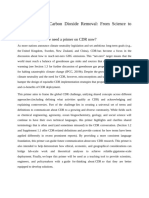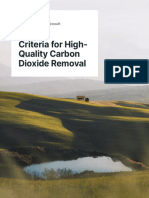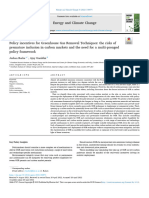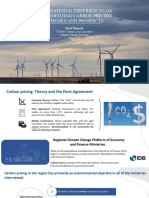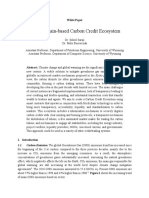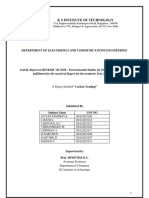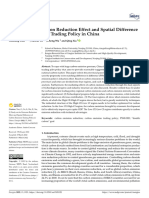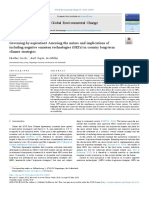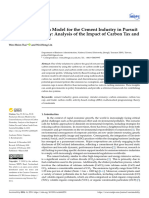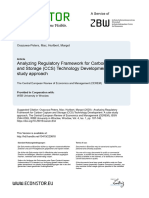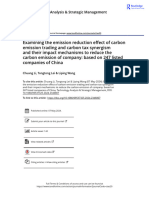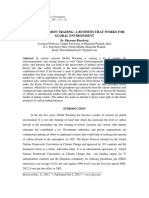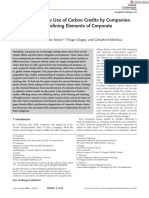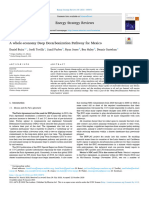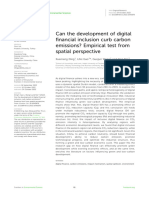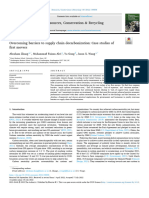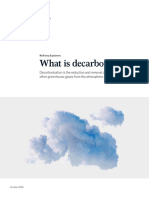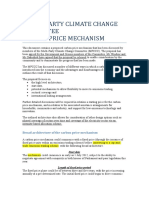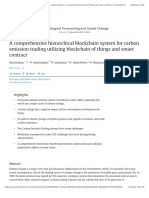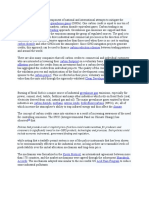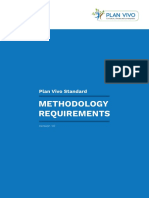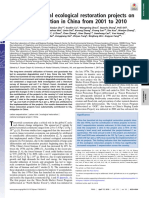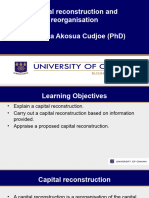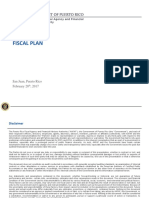Fclim 04 1101525
Fclim 04 1101525
Uploaded by
Muhammad Iqbal FirdausCopyright:
Available Formats
Fclim 04 1101525
Fclim 04 1101525
Uploaded by
Muhammad Iqbal FirdausOriginal Title
Copyright
Available Formats
Share this document
Did you find this document useful?
Is this content inappropriate?
Copyright:
Available Formats
Fclim 04 1101525
Fclim 04 1101525
Uploaded by
Muhammad Iqbal FirdausCopyright:
Available Formats
TYPE Review
PUBLISHED 18 January 2023
DOI 10.3389/fclim.2022.1101525
A review of commercialisation
OPEN ACCESS mechanisms for carbon dioxide
removal
EDITED BY
Soheil Shayegh,
European Institute of Economics and
the Environment, Italy
REVIEWED BY
Conor Hickey1*, Sam Fankhauser2 , Stephen M. Smith2 and
Asbjørn Torvanger,
Centre for International Climate and Myles Allen1,3
Environmental Research
1
(CICERO), Norway Environmental Change Institute, School of Geography, University of Oxford, Oxford,
Udayan Singh, United Kingdom, 2 Smith School of Enterprise and the Environment, School of Geography, University
Northwestern University, United States of Oxford, Oxford, United Kingdom, 3 Atmospheric, Oceanic and Planetary Physics, Department of
Physics, University of Oxford, Oxford, United Kingdom
*CORRESPONDENCE
Conor Hickey
conor.hickey@ouce.ox.ac.uk
The deployment of carbon dioxide removal (CDR) needs to be scaled up
SPECIALTY SECTION
This article was submitted to to achieve net zero emission pledges. In this paper we survey the policy
Negative Emission Technologies, mechanisms currently in place globally to incentivise CDR, together with an
a section of the journal
Frontiers in Climate
estimate of what different mechanisms are paying per tonne of CDR, and how
those costs are currently distributed. Incentive structures are grouped into
RECEIVED 17 November 2022
ACCEPTED 28 December 2022 three structures, market-based, public procurement, and fiscal mechanisms.
PUBLISHED 18 January 2023 We find the majority of mechanisms currently in operation are underresourced
CITATION and pay too little to enable a portfolio of CDR that could support achievement
Hickey C, Fankhauser S, Smith SM and
Allen M (2023) A review of
of net zero. The majority of mechanisms are concentrated in market-based and
commercialisation mechanisms for fiscal structures, specifically carbon markets and subsidies. While not primarily
carbon dioxide removal. motivated by CDR, mechanisms tend to support established afforestation
Front. Clim. 4:1101525.
doi: 10.3389/fclim.2022.1101525 and soil carbon sequestration methods. Mechanisms for geological CDR
COPYRIGHT
remain largely underdeveloped relative to the requirements of modelled net
© 2023 Hickey, Fankhauser, Smith and zero scenarios. Commercialisation pathways for CDR require suitable policies
Allen. This is an open-access article and markets throughout the projects development cycle. Discussion and
distributed under the terms of the
Creative Commons Attribution License investment in CDR has tended to focus on technology development. Our
(CC BY). The use, distribution or findings suggest that an equal or greater emphasis on policy innovation may
reproduction in other forums is
be required if future requirements for CDR are to be met. This study can further
permitted, provided the original
author(s) and the copyright owner(s) support research and policy on the identification of incentive gaps and realistic
are credited and that the original potential for CDR globally.
publication in this journal is cited, in
accordance with accepted academic
practice. No use, distribution or KEYWORDS
reproduction is permitted which does
carbon dioxide removal, net zero, climate policy, business models, commercialisation
not comply with these terms.
1. Introduction
Most scenarios for meeting the Paris Agreement objective of limiting warming to
well-below 2◦ C and pursue efforts to 1.5◦ C include carbon dioxide removal (CDR), with
a primary focus on compensating for temporary carbon budget overshoot and offsetting
expensive-to-abate emissions (IPCC, 2022). Scaling up CDR to the level required in
these scenarios will require policies, incentives, obligations, and commercialisation
mechanisms (hereafter “mechanisms”). However, the degree to which current and
proposed mechanisms will contribute to achieving net zero targets is unclear.
Frontiers in Climate 01 frontiersin.org
Hickey et al. 10.3389/fclim.2022.1101525
As CO2 remains in the atmosphere for millennia after being cases, not available to geological CDR. Outside of California,
emitted, a durable state of net zero emissions will only be there are few current examples of a coordinated portfolio
achieved if CO2 removed from the atmosphere is stored on an of mechanisms which attempt to achieve a balance between
equivalent timescale (Fankhauser et al., 2021). Currently, among geological and biological CDR options. Existing mechanism
other factors, the prices, durability, and development of both explicitly focused on CDR are geographically concentrated in the
biological and geological CDR approaches differ greatly (IPCC, UK, USA (mostly California) and New Zealand.
2022). The likely outcome with biological CDR is shorter-term The remainder of this paper is organised as follows: the
carbon storage, which makes it best suited to addressing land-use next section introduces a survey of CDR commercialisation
emissions (Alcalde et al., 2018). Although geological CDR has pathways, including an explanation of how they work as well as
the potential to permanently remove emissions, these techniques an analysis of their prices and scale. The analysis concludes in
can have higher costs, need to demonstrate efficacy and be Section 3.
proven at scale (Fuss et al., 2018).
Different CDR approaches require different policy support
based on factors including their business model, maturity and 2. Mechanisms
cost. For instance, R&D pilot project subsidies may be more
effective at the early stages of development, followed by long Mechanisms which support CDR can operate on a scale
term policy that is results-based and included in broader between fully market-based or dependant on fiscal incentives.
policy instruments (Honegger et al., 2021). Beyond early- We identify three broad incentive structures:
stage research and development funding, government action Market-based mechanisms include carbon markets and
to address CDR’s “incentive gap” remains limited (Fridahl prices and tradable obligation schemes. They focus on the
et al., 2020). Few results-based policy instruments for CDR principle of payment by polluters or suppliers of fossil fuels. In
are currently in use, especially for geological CDR, which these markets “removal units” (RUs),1 representing one tonne of
continues to be heavily dependent on funding for pilot projects CO2 removed, can be bought and sold.
(Schenuit et al., 2021). Interventions will be required alongside Public procurement mechanisms can provide a minimum
direct financial incentives to address additional barriers, such as level of return, price or demand to suppliers within an existing
developing skills and CO2 transport and storage (Zhou et al., market-based mechanism. These incentives tend to focus on
2022). Portfolio-based risk management approaches may also results-based payments of CO2 removed or reduced rather than
be required to support the diversity of risk by each CDR type grants focused on costs incurred.
(Nemet et al., 2018). Subsidy and tax credit mechanisms are the purest form
To our knowledge, this is the first paper to survey policy of fiscal incentive in which the state contributes a significant
mechanisms around the world to catalogue their present cost amount to the cost of developing and operating the CDR rather
and scale. A combination of web-based keyword searches, than the direct polluter.
reviews of policy documents and interviews with stakeholders Once mechanisms were identified through web-based
were used to identify mechanisms. Key criteria for the inclusion searches, reviewing of policy documents and interviews with
of a mechanism in this analysis includes the presence of some stakeholders they were grouped into the typology in Figure 1.
form of government oversight and support beyond a first- The Appendix contains a list of the key search terms used, and
of-a-kind project. These conditions preclude some voluntary the analysis has been updated as of September 2022.
carbon markets, which also have inherent uncertainty and issues Figure 1 generalises all of the mechanisms reviewed into five
with environmental integrity, and non-scalable mechanisms mechanism type categories based on how costs are distributed
including funds for trials, research and innovation. We between polluters (market-based) and governments (fiscal
note recent innovations, including Frontier’s advanced market incentives). Mechanism types include: Carbon Markets and
commitment model, are emerging to overcome some of these Prices, Tradable Obligation Schemes, Results-based Payments,
voluntary carbon market limitations (Frontier Climate, 2022). Subsidy and Tax Credit. Mechanism types may also need to
We find that globally, there are limited examples of ensure that cash flows from projects are predictable, consistent
mechanisms which explicitly incentivise the deployment of and have certainty to be more attractive to investors.
CDR. Operational market-based mechanisms pay between
e1/tCO2 and e88/tCO2 , public procurement type mechanisms
pay between e10/tCO2 and e100/tCO2 and direct fiscal 1 Known as Air Resource Board offset credits in the C&T, China Certified
incentives pay between e0.5/tCO2 and e180/tCO2 . While not Emission Reductions in the CETS, CO2 Removal Credits in Rickels et al.
primarily motivated by CO2 removal, mechanisms tend to (2021), negative emission credits in Cabral et al. (2019), Australian carbon
support established afforestation and soil carbon sequestration credit units or carbon abatement contracts in the ERF, Woodland Carbon
methods. Although geological storage is covered in some Units in the WCG, New Zealand Units in (NZE), negative emissions
schemes, the incentives they provide are inadequate and, in some payment (NEPs) in Element Economics and Vivid Economics.
Frontiers in Climate 02 frontiersin.org
Hickey et al. 10.3389/fclim.2022.1101525
FIGURE 1
Categorisation of mechanisms. Carbon pricing and markets: WCC, Woodland Carbon Code; C&T, California Cap and Trade; NZE, New Zealand
ETS; LBC, Label Bas Carbone; RHC, Registro de Huella de Carbono; CCT, Colombia’s Carbon Tax; CETS, China ETS; QC, Québec Cap-and-Trade
System; KE, Korean ETS; KZE, Kazakhstan ETS; SETS, Saitama’s ETS; COETS, Colombia ETS. Tradeable obligation scheme: LCFS, Low-Carbon
Fuel Standard; KF, Klik foundation; CTBO, Carbon Take Back Obligation. Results-based payments: WCG, Woodland Carbon Guarantee; ERF,
Emissions Reductions Fund; CfD, Contract for Difference; SRA, Swedish Reverse Auction. Subsidy: CSS, Countryside Stewardship Scheme; WCF,
Woodland Carbon Fund; 1BTF, One Billion Trees Fund; CRP, Conservation Reserve Program; HSP, CDFA Healthy Soils Program; SL, Sowing Life;
IAS, Ireland’s Afforestation Scheme; PES, Costa Rica’s; NICFI, Norway’s; ELMS, Environment Land Management Scheme; RDH, Regional Direct Air
Capture Hubs. Tax credit: 45Q, 48a/b tax code, Canada Tax Credit.
2.1. Carbon pricing and markets used in the UK Emissions Trading Scheme (ETS) or outside
the UK (including shipping and aviation) and reporting is
Carbon pricing and market schemes targeting emissions required every 10 years after the first 5 years. Follow up reports
reductions in certain sectors of the economy can allow for the are required every 5 years with Spain’s RHC and third party
use of CDR through offsets. While we focus here on markets verification of ex-post GHG emissions if a buyer retires RUs.
for CDR, it should be noted that the majority of carbon offsets Both Colombia and Chile have a carbon tax of
traded in markets currently come from reduced or avoided approximately US$5/tCO2 e. In Columbia companies can
emissions rather than removals (Shankleman and Rathi, 2021). avoid paying the tax by purchasing carbon offsets from projects
The UKs Woodland Carbon Code (WCC), Spain’s Registro de located in Colombia. Accepted offsets include afforestation,
Huella de Carbono (RHC), and France’s Label Bas-Carbone improved forest management and REDD+ projects as
(LBC) operate as domestic carbon standards which participate in well as agricultural and grassland management projects.
voluntary carbon markets. Requirements of issued certificates to The Colombian Government is expected to trial an ETS
be surrendered to buffer accounts range from 20% for the WCC, (COETS) which will allow for removals to offset emissions as a
10% for the RHC and 10–25% for the LBC depending on the complementary policy to the carbon tax between 2023 and 2024
projects reversal risk (Cevallos et al., 2019; WCC, 2019a,b). Each (Cevallos et al., 2019). The Chilean government is currently
standard is administered directly or indirectly by a government working on developing offset regulation which could allow
ministry and forestry projects are expected to last 30 years in regulated entities to offset part or all of their emissions subject
the RHC and LBC or up to 100 years in the WCC. The WCC to the tax. Offsets, their threshold limits, and their transactions
and RHC use public registries to sell RUs whereas in the LBC are expected to be operational in 2023 (ICAP, 2021b).
RUs are negotiated and traded directly between the project Some ETSs already have experience with the use of RUs,
owner and the buyer. LBC largely focuses on afforestation and albeit primarily in the context of offsets from afforestation
reforestation projects but is expected to expand to other forms and reforestation projects. Generally, offset projects must be
of sequestration including agroforestry soil carbon in agriculture located within the same nation as the ETS or in regions where
and mangroves (Cevallos et al., 2019). WCC units cannot be ETSs are linked. Examples include in California (C&T), Québec
Frontiers in Climate 03 frontiersin.org
Hickey et al. 10.3389/fclim.2022.1101525
(QC), China (CETS) and the Korean ETS (KE)—all of which Cabral et al. (2019) find repurposed coal to Bioenergy with
established quantitative limits and qualitative criteria for offset Carbon Capture and Storage (BECCS) plants could reduce
use. Compliance entities may use RUs to meet up to 4% of their the levelized cost of BECCS plants to between $70/MWh
emissions compliance in the C&T, 5% in the CETS and 8% in and $100/MWh, achieved through auctioning RUs at between
the QC (EDF, 2020; CARB, 2021; ICAP, 2021a). Each project $90/tCO2 and $135/tCO2, with a sequestration potential of
that is issued offset credits contributes between 17 and 19% in 9GtCO2 (Cabral et al., 2019). Subsequent analysis has found that
the C&T and 3% in the QC of their total credits into a buffer incentivising CDR through RUs could mean that lower levels of
account (ARB, 2021; ICAP, 2021a). Mexico’s proposed national carbon taxation are needed to meet the Paris Agreement, which
ETS (ME), currently in a pilot phase, is expected to allow in turn lowers electricity costs (Daggash and Mac Dowell, 2019).
proposed participants to meet up to 10% of their compliance Value pool analysis of business models for BECCS, DACs and
obligations with offsets generated domestically. Kazakhstan’s Distributed Biomass supports these findings, concluding that
Emissions Trading Scheme (KZE) allows for the use of domestic access to carbon credit mechanisms, has by far the greatest near-
offsets without quantitative limits but projects are expected to term potential to drive negative emissions technologies (Platt
apply Clean Development Mechanism principles (EDF, 2015; et al., 2018).
ICAP, 2021c). In Japan, the Saitama’s ETS is linked to Tokyo’s
Cap-and-Trade Program and allows for forest absorption credits
to be used as offsets (ICAP, 2022a). New Zealand’s ETS (NZE)
awards allowances for removals from forestry, without a limit 2.2. Tradable obligation schemes
on the total number of units from those activities that can
go into the ETS. Owners of forest land created after 1989 in Governments can place obligations or standards on
New Zealand can voluntarily join its ETS and receive RUs as companies to reduce their emissions directly or trade with other
their forest grows. Owners of non-exempt pre-1990 forest land companies to offset their emissions, though this is less common.
are required to participate in the system and are subject to its For example, the US Renewable Portfolio Standards require that
obligations if they deforest (ICAP, 2022b). a specified percentage of the electricity utilities sell comes from
Operators who perform CCS in Europe can retain renewable resources. Under the Swiss CO2 Act, importers of
allowances when emissions have been verified as captured and motor fuels are required to offset up to 90% of their emissions. In
transported for permanent storage under the European ETS support of the obligation, the Foundation for Climate Protection
(EU ETS) (Council Directive 2018/410/EC). While there is no and Carbon Offset (KliK) was founded as a sector-wide carbon
current provision for CDR in the EU ETS, several potential offset grouping for motor fuel suppliers. The KliK Foundation
methods for inclusion have been proposed. Rickels et al. (2021) funds projects that generate carbon offset credits based on a
propose that a regulatory authority could procure removal units Swiss carbon standard, which could include forestry, through a
into the market as a method to incentivise geological CDR levy placed on consumers (st1, 2021). California’s Low-Carbon
too, a prerequisite to the approach would be the creation of Fuel Standard (LCFS) sets annual carbon intensity benchmarks
an unused allowance pool that could be designated as RUs on the full lifecycle emissions of transport fuels sold, supplied or
(Rickels et al., 2021). The European Commission has proposed offered for sale in California. Projects that directly capture CO2
that a Carbon Removal Certification Scheme could be integrated from the air can generate LCFS credits and be sold to buyers
into the EU ETS in 2030 (European Commission, 2021a). who exceed their carbon intensity benchmark (Townsend and
Hickey and Allen (2021) propose a “European Removals Fund”, Havercroft, 2019). Operators must agree to monitor the project
funded by allowances from the ETS and other sources, which for 100 years after injection, demonstrate a low probability
could use a reverse auction to procure removals required to (<10%) of leakage with 8–16.4% of credits allocated to a buffer
offset hard-to-abate sectors in Europe. Applying a temporary account. Funds must also be ring fenced for maintenance,
multiplier value on allowances to match the cost of RUs project closure, and potential accidents (CARB, 2018). Projects
from geological CDR is also considered in their analysis i.e., are not restricted to California and may be located anywhere.
operators of removals receive a multiple of allowances which In a Carbon Take Back Obligation (CTBO), currently at a
match their costs (Hickey and Allen, 2021). ETS allowances conceptual stage, producers or importers of carbon compounds
could also be limited to a specific global-warming goal, but must sequester/store an increasing fraction of the CO2 produced
allowances for further emissions in the form of carbon debt from their products by acquiring RUs in-house or externally
which needs to be removed in future could be issued. Emitters (100% by 2050) (Allen et al., 2009; Kuijper et al., 2021). Jenkins
pay for temporary storage in the atmosphere through interest et al. (2021) find a CTBO could be comparable in cost, including
payments on their carbon debt (Bednar et al., 2021). Bednar economic costs, to similar ambition scenarios dominated by
et al. (2021) conclude that this would lead both to earlier demand-side measures simulated by a global carbon price. In
reductions in carbon emissions and to earlier application of the near term, demand-side policy is required to incentivise
removal technologies. emissions reductions before the CTBO stored fraction increases
Frontiers in Climate 04 frontiersin.org
Hickey et al. 10.3389/fclim.2022.1101525
significantly enough to disincentive fossil fuel use (Jenkins et al., on the ETS price, with NEPs set at £92/tCO2 and CfDc set at
2021). £107/tCO2 (Element Energy and Vivid Economics, 2021). The
state could recoup NEP costs by selling a NEP on the voluntary
market, or the plant operator could sell a NEP at a discount
2.3. Results-based payments (£40/tCO2 ) on the voluntary market, with the state covering
the difference. Europe’s Innovation Fund, funded through
Governments can also use mechanisms to procure a allowances it sells in the EU ETS, could hypothetically provide
fixed level of demand or price per tonne of CDR in an support to projects through competitive tendering mechanisms
existing mechanism. Australia’s Emissions Reduction Fund such as CfDcs, but may be limited to second, or third of a
(ERF) provides incentives to businesses to cut the amount of kind projects (European Commission, 2021b). CfDcs may raise
greenhouse gases they create and to undertake activities that problems for an ETS forward market, effectively reducing the
store carbon. RUs can be sold to the government through a need for market participants to hedge their risks leading to
carbon abatement contract or in the unregulated secondary reduced overall liquidity and thus less efficient price-formation
market as an offset (Inoplex, 2018). RUs are secured through (Europex, 2021).
a competitive bidding process based on lowest cost per tCO2
(Clean Energy Regulator, 2022). The UK’s Woodland Carbon
Guarantee (WCG) allows landowners, who can also participate 2.4. Subsidies
in the WCC, to sell captured carbon from their forests to the
government in the form of verified RUs for a guaranteed price Subsidies can involve the direct payment by governments
every 5 or 10 years up to 2055/56 (Forestry Commission, 2020, to CDR project operators for the costs they incur. The UK’s
2021). At years 5 and 15 the UK Accreditation Service checks if Countryside Stewardship Scheme (CSS) and Woodland Carbon
the predicted or actual carbon sequestration is materially correct Fund (WCF), New Zealand’s One Billion Trees Fund (1BTF)
(WCC, 2019c). and Ireland’s Afforestation Scheme (IAS) offer direct grants
SDE++ in the Netherlands covers the cost of CCS operation paid per hectare (DEFRA, 2021b; MPI, 2021; Rural Payments
above the EU ETS price and exempts industrial facilities from Agency, 2021; Department of Agriculture Food and the Marine,
the Dutch carbon tax for CO2 captured and stored. Projects are 2022). IAS also covers the cost of afforestation. Mexico’s Sowing
ranked based on their subsidy intensity and only projects below Life (SL), intended to help meet climate goals with synergistic
the cost threshold for CCS could participate in the auction. aims to support the country’s efforts to reduce poverty and
Calculating the subsidy intensity is done by taking the base inequality, provides direct grants paid per farmer rather than per
rate from the application and subtracting the long-term price hectare. The US Conservation Reserve Program (CRP) operates
divided by the emission factor (Andreas, 2021). Between 2026 on both a cost-share assistance basis (up to 50%) and financial
and 2040, the Swedish government will use a reverse auction incentives (additional 20% of soil rental rate) (Newton, 2020).
(SRA) to distribute SEK 400 million per year to BECCS operators Each mechanism can fund forestry, CSS and CRP consider
who submit the lowest cost bids (Regeringen, 2021). Zetterberg soil restoration too, but only the WCF and 1BTF focus on
et al. (2021) proposes a similar auction approach focused on carbon sequestration. Participants in the 1BTF can register their
guarantees, followed by a larger quota obligation scheme or forests for carbon credits in the NZ ETS and therefore must
integration of BECCS into the EU ETS to scale up BECCS adhere to its liability mechanism (Menzies, 2020). The proposed
in Sweden. They also considered a voluntary compensation Environmental Land Management Scheme (ELMS) in the UK
scheme or international transfers of BECCS outcomes, but could fund some forms of soil carbon sequestration, biochar,
conclude these two approaches were too uncertain for the short and enhanced weathering (DEFRA, 2021a). The Climate-Smart
term (Zetterberg et al., 2021). Honegger and Reiner (2018) Practice Incentive aims to increase sequestration through trees,
also consider international transfers of outcomes through the permanent grasses and wetland restoration under the CRP
Sustainable Development Mechanisms (SDM), which allow for although a funding mechanism is not yet established (USDA,
voluntary transfers of mitigation units in exchange for payment 2021). California’s Healthy Soils Program (HSP) is funded
of a price per tonne of CO2 avoided emissions or removal by from the State’s cap and trade proceeds. The HSP distributes
the receiving country. The received units might then be counted funds through grants for: cover cropping, no-till, reduced-
towards the buyer country’s mitigation target or its climate till, mulching, compost application, and conservation plantings
finance pledges (Honegger and Reiner, 2018). (CDFA, 2022). The Regional Direct Air Capture Hubs (RDH)
A CfD is a contract that pays the differences in the market program in the USA will support four large-scale, regional
price and an agreed price or cost for CDR. Conceptual policy direct air capture hubs that each comprise a network of
analysis suggests funding for BECCS in the UK from CfD CDR projects worth $3.5 billion (USDOE, 2022). Costa Rica’s
mechanisms on electricity pricing (CfDe), with a Negative Payments for Environmental Services Program (PES) provides
Emissions Payment (NEP) and a standalone carbon CfD (CfDc) landowners with direct payments for the environmental services
Frontiers in Climate 05 frontiersin.org
Hickey et al. 10.3389/fclim.2022.1101525
that their lands produce when adopting sustainable land-use and 2.6. Costs and scale by mechanism type
forest-management techniques. Funding comes from a variety
of sources including fuel tax and water charge, Certificates This section illustrates the price and potential scale for each
of Conservation of Biodiversity, carbon credits, and strategic mechanism described in Sections 2.1–2.5 where possible. For
alliances with the public and private sector (UN Climate Change, some market-based mechanisms the level of CDR is not reported
2020). Through its international climate and forest initiative and the theoretical potential is used i.e., the maximum amount
(NICFI), the Norwegian government seeks to promote efforts of CDR that could receive a payment in that market.
to slow, halt, and ultimately reduce greenhouse gas emissions Figure 2 shows the range of average prices per tonne of
caused by deforestation and forest degradation in developing CO2 available in each mechanism by CDR type, as well as the
countries (REDD+) (Norad, 2020). potential scale for each mechanism. Supplementary Table A1
presents the prices and scale for each of the mechanisms
assessed. Mechanisms without either a price or scale reported
which could not be plotted are available in the Appendix.
2.5. Tax credits Current prices for forestry can come close to or exceed
cost estimates of e40/tCO2 in KF, WCG, and CRP, however
Tax credits reduce the amount of income tax companies upper estimates by the IPCC can rise to e240/tCO2 (Fuss et al.,
operating CDR owe to governments. Section 45Q of the US tax 2018; IPCC, 2022). The remaining mechanisms, which comprise
code offers a tax credit for geologic CO2 storage in general, and the majority of biological CDR’s total scale, are estimated to
so both BECCS and Direct Air Carbon Capture and Storage pay below e20/tCO2 . IPCC cost estimates of DACCS and
(DACCS) are eligible (Bright, 2021). The credit is based on the BECCS which can rise to e300/tCO2 and e400/tCO2 in
amount of CO2 captured and is provided to the company that cost, respectively are above current prices in all mechanisms.
captures it. CO2 must either be placed in permanent geological Policy documents for BECCS in the UK indicate a price of
storage or utilised in products (e.g., plastics and cement), as between e107/tCO2 and e151/tCO2 (Element Energy and
well as enhanced oil recovery (EOR). CDR projects are likely to Vivid Economics, 2021). Spot prices for DACCS today can
require higher financial incentives than CCS projects involving rise to between e204/tCO2 and e2,132/tCO2 for voluntary
high-purity CO2 capture or EOR. The taxpayer has to repay the purchases (cdr.fyi, 2022). However, voluntary markets have had
tax credit (credit recapture) to the Treasury if the carbon dioxide an average price of e4/tCO2 in 2021, which is also below
ceases to be captured, disposed of, or used in a qualifying manner the costs of these technologies (Ecosystem Marketplace, 2022).
(CRS, 2021). The Inflation Reduction Act of 2022 increased Contracts with better terms are possible outside of the voluntary
the 45Q tax credit to between $85/tCO2 and $180/tCO2 for market. In these instances, the purchaser of credits is typically
geological CDR (Clean Air Task Force, 2022). For DAC facilities, a large corporation or consortia (e.g., Microsoft, Airbus and
the CO2 capture threshold decreased from 100,000 tonnes Frontier) placing a low volume prepurchase of CDR based on
captured per year to 1,000 tonnes per year. Sanchez et al. a maximum spend (Joppa et al., 2021; 1PointFive, 2022; Frontier
(2018) estimate that a $60/tCO2 sequestration credit (e.g., the Climate, 2022). Reforms to the 45Q result in prices for DAC
45Q) may result in the sequestration of 30 MtCO2 , while a and BECCS of e180/tCO2 and e85/tCO2 , respectively. SDE++
$90/tCO2 carbon abatement credit (e.g., LCFS in Section 2.1) may incentivise geological storage but could be too low to
might incentivise the reduction of 38 MtCO2 (Sanchez et al., support removal. The LCFS maintained a price of ∼e200/tCO2
2018). Edwards and Celia (2018) estimate that the use of direct in 2019 and 2020 until recently declining to e68/tCO2 in
government financing in addition to the 45Q tax credit could September 2022. The price decline arose from a sharp rise in
lead to capturing an additional 19–30 MtCO2 profitably each new credits from renewable gas projects due to a combination
year (Edwards and Celia, 2018). of interlocking incentives (Blackburn, 2022). It is possible to
Vivid Economics (2019) propose a similar tax credit for the combine mechanisms to achieve higher prices to cover CDR
UK, potentially funded by a carbon levy. They also suggest the costs. For example, the LCFS and 45Q, NZE and 1BTF, the WCF
tax credit could apply to the initial capital investment (similar and CSS with the WCC. Generally, subsidies can be combined
to the US 48 a/b tax code) and be tradeable between companies with other mechanisms.
(Vivid Economics, 2019). Canada recently proposed a CCUS The theoretical potential scale of operational mechanisms
tax credit offered on the cost of purchasing or installing eligible which support geological storage of CO2 in this survey
equipment used in a CCUS project. The credit works on an is estimated at 0.95 GtCO2 in total, the total scale of
initial sliding scale of 60% for equipment on a direct air capture operational mechanisms supporting biological storage is
project, 50% for other eligible capture equipment and 37.5% estimated at 0.273 GtCO2 . These numbers represent the
for transport, storage and use equipment (Johnson et al., 2022). potential scale of mechanisms for which estimates could be
Liability for released CO2 is expected to be managed through a established, not how much CO2 is currently being removed
recovery of tax credit mechanism (EY, 2022). and stored.
Frontiers in Climate 06 frontiersin.org
Hickey et al. 10.3389/fclim.2022.1101525
FIGURE 2
Current potential scale and price of mechanisms by CDR type (converted from base currency to e in September 2022). Carbon pricing and
markets: WCC, Woodland Carbon Code; C&T, California Cap and Trade; NZE, New Zealand ETS; LBC, Label Bas Carbone; RHC, Registro de
Huella de Carbono; CCT, Colombia’s Carbon Tax; CETS, China ETS; QC, Québec Cap-and-Trade System; KE, Korean ETS; KZE, Kazakhstan ETS;
SETS, Saitama’s ETS; COETS, Colombia ETS. Tradeable obligation scheme: LCFS, Low-Carbon Fuel Standard; KF, Klik foundation; CTBO, Carbon
Take Back Obligation. Results-based payments: WCG, Woodland Carbon Guarantee; ERF, Emissions Reductions Fund; CfD, Contract for
Difference; SRA, Swedish Reverse Auction. Subsidy: CSS, Countryside Stewardship Scheme; WCF, Woodland Carbon Fund; 1BTF, One Billion
Trees Fund; CRP, Conservation Reserve Program; HSP, CDFA Healthy Soils Program; SL, Sowing Life; IAS, Ireland’s Afforestation Scheme; PES,
Costa Rica’s; NICFI, Norway’s; ELMS, Environment Land Management Scheme; RDH, Regional Direct Air Capture Hubs. Tax credit: 45Q, 48a/b
tax code, Canada Tax Credit.
IPCC scenarios which keep temperatures at 1.5C with low geological CDR is considerably underdeveloped relative to
overshoot indicate annual volumes in 2050 for geological storage future requirements.
total 2.77 GtCO2 yr−1 , with 2.75 (0.52–9.45) GtCO2 yr−1 Figure 3 indicates that the majority of currently operational
coming from BECCS and 0.02 (0–1.74) GtCO2 yr−1 from mechanisms are concentrated in carbon markets and subsidies
DACCS. Net CO2 removal on managed land (including forestry) which mostly support biological CDR. Average prices in
is estimated at 2.98 (0.23–6.38) GtCO2 yr−1 (IPCC, 2022). IEA carbon pricing and market mechanisms tend to be lower than
estimates are lower for geological storage of 0.027 GtCO2 yr−1 other mechanisms. One reason for this is that prices are set
by 2030 and 1.93 GtCO2 yr−1 by 2050, through 0.2 GtCO2 yr−1 independently of the cost of CDR and can reflect the cost
of BECCS by 2030 and 1.3 GtCO2 yr−1 by 2050 and DACCS of allowances targeting mitigation. Higher prices for CDR are
at 0.07 GtCO2 yr−1 and 0.63 GtCO2 yr−1 , respectively (IEA, generally offered in the remaining mechanism types as they can
2021). A significant proportion of biological CDR is not covered be tied towards the cost of CDR, excluding the LCFS and ERF.
by mechanisms today, it is therefore difficult to compare it With the exception of the WCC, NZE, ERF and KF, the
with future biological CDR requirements in scenarios. However, estimates of scale for carbon pricing and markets and tradeable
Frontiers in Climate 07 frontiersin.org
Hickey et al. 10.3389/fclim.2022.1101525
FIGURE 3
Current potential scale and price by mechanism type (converted from base currency to e in September 2022).
obligation mechanisms represent their potential scale. Potential modelling scenarios. This review surveys current and proposed
scale represents the maximum amount of RUs that could commercialisation mechanisms for CDR globally. We estimate
theoretically be operating in the mechanism, reporting on the each mechanism’s payment per tonne of CO2 removed today
values of CDR in these mechanisms is limited. 45Q’s scale and scale of removal, then categorise mechanisms based on
includes several projects that will have received varying prices, how they distribute costs between the public and private
but 45Q in Figure 3 indicates the greatest price that could be sectors. The results presented in this paper are subject to
obtained through that mechanism. For all other mechanisms the uncertainty inherent to the data and assumptions used
and mechanism types the values for scale are either reported or to estimate prices and scale. It is possible that not all
estimated levels of direct CDR activity. The approached used to mechanisms that focus on afforestation, agricultural CDR and
generate estimates is outlined in the Appendix. One implication conservation have been captured. Using web-based searches
of overlapping mechanisms is that the mechanism scales in for mechanisms is the main source of this limitation, with
Figure 3 are not necessarily additive. mechanism details being published in languages outside of the
search terms used.
With minor exceptions the cost of both biological and
3. Conclusion geological CDR generally exceeds the funding that is available
under existing support mechanisms, particularly for market-
Mechanisms that support CDR are important to scale up based mechanisms. We find the majority of mechanisms
and deliver the removal capacity required in most net zero currently in operation are under-resourced and pay too little to
Frontiers in Climate 08 frontiersin.org
Hickey et al. 10.3389/fclim.2022.1101525
ensure sufficient development of CDR capacity compatible with biological CDR in suitable timelines. Emissions should be offset
net zero scenarios. Mechanisms tend to promote established with like-for-like CDR, with CO2 from fossil fuel sources being
practises like afforestation and soil carbon sequestration and are offset with geological storage. Robust lifecycle accounting and
not primarily motivated by CO2 removal. Existing mechanisms monitoring for CDR will also support the certainty of achieving
explicitly focused on carbon removal are geographically climate targets.
concentrated in the UK, USA (mostly California) and New
Zealand. There are multiple barriers, of which lack of demand
for CDR is one. The policy regime must address them all Author contributions
and that may require a suite of interventions (Zhou et al.,
2022). CH conceptualised the research with contributions from
As fiscal space potentially tightens, policymakers that MA, SF, and SS. CH drafted the manuscript and gathered
are considering the results of this research in the current the data. All authors revised and improved the manuscript.
economic climate may think about making greater use of All authors contributed to the article and approved the
markets and tradable obligation schemes to allocate a greater submitted version.
portion of the cost on the polluter. However, these mechanisms
can increase the risk of investment creating further barriers
Funding
that the certainty of contracts (e.g., CfD, feed-in tariffs)
would overcome. Policymakers could also mandate firms
This project has received funding from the European
to remove an increasing fraction of their CO2 over time,
Union’s Horizon 2020 Research and Innovation Program under
if the cost of geological CDR per tonne of CO2 remains
grant agreement No. 869192 (NEGEM). We also acknowledge
too expensive.
the support of Oxford Net Zero through the University of
There is a broad spectrum of CDR techniques, and a
Oxford’s Strategic Research Fund and CO2RE funded by UKRI
variety of support mechanisms may be needed to reflect
(grant reference NE/V013106/1).
their differences. Many CDR techniques are in the early
stages of development and may require more immediate
types of support before progressing to the longer-term Acknowledgments
mechanisms analysed in this review. For example, there
could be a progression from subsidies to results-based We are grateful for comments from Mirte Boot, David
mechanisms. Larger mechanisms may emerge once Reiner, Keith Whiriskey, and Nijia Zhou.
CDR techniques reach a suitable level of maturity and
scale, but in order to obtain investment, CDR projects
are likely to need clarity on those longer-term larger Conflict of interest
mechanisms today.
CDR is not a substitute for emissions reductions. However, The authors declare that the research was conducted in the
like other forms of carbon offsets, incentives for CDR can absence of any commercial or financial relationships that could
have negative impacts on the level of emissions reductions be construed as a potential conflict of interest.
and increase the uncertainty over whether an emissions target
has been reached (Haya et al., 2020). Direct inclusion of CDR Publisher’s note
through RUs in existing mechanisms can also still be limited
in scaling CDR deployment. For example, low and volatile All claims expressed in this article are solely those of the
carbon prices, liability risks for CDR, and questions of public authors and do not necessarily represent those of their affiliated
acceptability if emissions don’t appear to be declining could all
organizations, or those of the publisher, the editors and the
be factors limiting CDR inclusion in carbon markets (Hickey reviewers. Any product that may be evaluated in this article, or
et al., 2022). Legislation on the neutral reporting of biomass claim that may be made by its manufacturer, is not guaranteed
in carbon markets may also limit the potential of BECCS or endorsed by the publisher.
(Rickels et al., 2021). Mechanisms for CDR will need effective
protocols and oversight to mitigate these uncertainties and
unintended consequences. Focusing on near term climate action Supplementary material
with clear plans to achieve it will be fundamental. The plan
should prioritise emissions reductions and define a clear role for The Supplementary Material for this article can be
CDR in a net zero target. Policies should be required to prove found online at: https://www.frontiersin.org/articles/10.3389/
that they will be able to deliver a required level of geological or fclim.2022.1101525/full#supplementary-material
Frontiers in Climate 09 frontiersin.org
Hickey et al. 10.3389/fclim.2022.1101525
References
1PointFive (2022). 1PointFive Announces Agreement With Airbus for the default/files/documents/Analytical-Report_on_the_Status_of_the_China_GHG_
Purchase of 400,000 Tonnes of Carbon Removal Credits. Available online at: https:// Voluntary_Emission_Reduction_Program-ENG.pdf
www.oxy.com/news/news-releases/1pointfive-announces-agreement-with-
Edwards, R. W. J., and Celia, M. A. (2018). Infrastructure to enable deployment
airbus-for-the-purchase-of-400000-tonnes-of-carbon-removal-credits/
of carbon capture, utilization, and storage in the United States. Proc. Natl. Acad.
Alcalde, J., Flude, S., Wilkinson, M., Johnson, G., Edlmann, K., Bond, Sci. U. S. A. 115, E8815–E8824. doi: 10.1073/pnas.1806504115
C. E., et al. (2018). Estimating geological CO2 storage security to deliver
on climate mitigation. Nat. Commun. 9, 1–13. doi: 10.1038/s41467-018-04 Element Energy and Vivid Economics (2021). Investable Commercial
423-1 Frameworks for Power BECCS Prepared by Element Energy and Vivid Economics.
Available online at: https://assets.publishing.service.gov.uk/government/
Allen, M. R., Frame, D. J., and Mason, C. F. (2009). The case for mandatory uploads/system/uploads/attachment_data/file/1026637/investable-commercial-
sequestration. Nat. Geosci. 2, 813–814. doi: 10.1038/ngeo709 framework-power-beccs.pdf
Andreas, J. (2021). The Industrial CCS Support Framework in the Netherlands. European Commission (2021a). Communication From the Commission to
Available online at: https://network.bellona.org/content/uploads/sites/3/2021/07/ the European Parliament and the Council on Sustainable Carbon Cycles.
The-Industrial-CCS-Support-Framework-in-the-Netherlands-1.pdf Available online at: https://ec.europa.eu/transparency/documents-register/detail?
ARB (2021). California’s Compliance Offset Program. Available online at: https:// ref=COM(2021)800&lang=en
ww2.arb.ca.gov/sites/default/files/2021-10/nc-forest_offset_faq_20211027.pdf European Commission (2021b). Revised EU ETS With Annex. Available online
at: https://ec.europa.eu/info/sites/default/files/revision-eu-ets_with-annex_en_0.
Bednar, J., Obersteiner, M., Baklanov, A., Thomson, M., Wagner, F., Geden, O.,
pdf
et al. (2021). Operationalizing the net-negative carbon economy. Nature 596, 1–7.
doi: 10.1038/s41586-021-03723-9 Europex (2021). Carbon Contracts for Difference (CCfDs) and Their Potentially
Distortive Effects on Emission Markets: Call for a Comprehensive Impact
Blackburn, E. (2022). Falling LCFS Credit Price Narrows RNG Prospects.
Assessment. Available online at: https://www.europex.org/wp-content/uploads/
Argus Media. Available online at: https://www.argusmedia.com/en/news/2333804-
2021/05/20210531_Europex-position-paper-on-CCfDs.pdf
falling-lcfs-credit-price-narrows-rng-prospects
EY (2022). EY Tax Alert 2022 no 41 - Proposed Federal Investment Tax Credit
Bright, M. (2021). 45Q: The “Most Progressive CCS-Specific Incentive Globally”
for Carbon Capture, Utilization and Storage — Update. Available online at: https://
Is Now Open for Business - Global CCS Institute. Available online at: https://
www.eylaw.ca/en_ca/newsroom/2022/tax-alert-2022-no-41
www.globalccsinstitute.com/news-media/insights/45q-the-most-progressive-
ccs-specific-incentive-globally-is-now-open-for-business/ Fankhauser, S., Smith, S. M., Allen, M., Axelsson, K., Hale, T., Hepburn, C., et al.
(2021). The meaning of net zero and how to get it right. Nat. Clim. Change 12, 1–7.
Cabral, R. P., Bui, M., and Mac Dowell, N. (2019). A synergistic approach
doi: 10.1038/s41558-021-01245-w
for the simultaneous decarbonisation of power and industry via bioenergy with
carbon capture and storage (BECCS). Int. J. Greenh. Gas Control 87, 221–237 Forestry Commission (2020). Woodland Carbon Guarantee. GOV.UK. Available
doi: 10.1016/j.ijggc.2019.05.020 online at: https://www.gov.uk/guidance/woodland-carbon-guarantee
CARB (2018). Carbon Capture and Sequestration Protocol Under the Low Carbon Forestry Commission (2021). Guide to the Fourth Auction. Available online
Fuel Standard. Available online at: https://ww2.arb.ca.gov/sites/default/files/2020- at: https://wcag.naturebid.org.uk/
03/CCS_Protocol_Under_LCFS_8-13-18_ada.pdf
Fridahl, M., Bellamy, R., Hansson, A., and Haikola, S. (2020). Mapping
CARB (2021). Compliance Offset Program. California Air Resources Board. multi-level policy incentives for bioenergy with carbon capture and
Available online at: https://ww2.arb.ca.gov/our-work/programs/compliance- storage in Sweden. Front. Clim. 2, 604787. doi: 10.3389/fclim.2020.6
offset-program/about 04787
CDFA (2022). CDFA Healthy Soils Program. Available online at: https://www. Frontier Climate (2022). How Frontier Works. Available online at: https://
cdfa.ca.gov/oefi/healthysoils/docs/HSP_flyer_2022.pdf frontierclimate.com/
cdr.fyi (2022). cdr.fyi Methodology. Available online at: https://www.cdr.fyi/ Fuss, S., Lamb, W. F., Callaghan, M. W., Hilaire, J., Creutzig, F., Amann, T., et al.
(2018). Negative emissions—Part 2: costs, potentials and side effects. Environ. Res.
Cevallos, G., Grimault, J., and Bellassen, V. (2019). Domestic carbon standards
Lett. 13, 063002. doi: 10.1088/1748-9326/aabf9f
in Europe overview and perspectives.
Haya, B., Cullenward, D., Strong, A. L., Grubert, E., Heilmayr, R., Sivas,
Clean Air Task Force (2022). Carbon Capture Provisions in the Inflation
D. A., et al. (2020). Managing uncertainty in carbon offsets: insights
Reduction Act of 2022 45Q Enhancements in the Inflation Reduction Act.
from California’s standardized approach. Clim Policy 20, 1112–1126.
Available online at: https://cdn.catf.us/wp-content/uploads/2022/08/19102026/
doi: 10.1080/14693062.2020.1781035
carbon-capture-provisions-ira.pdf
Hickey, C., and Allen, M. R. (2021). Quantitative Survey of Commercialisation
Clean Energy Regulator (2022). ERF Auction April 2022. Available online
Mechanisms. Available online at: https://www.negemproject.eu/wp-content/
at: https://www.cleanenergyregulator.gov.au/ERF/auctions-results/april-2022
uploads/2021/12/D-2.1-Quantitative-survey-of-commercialisation.pdf
CRS (2021). The Tax Credit for Carbon Sequestration (Section 45Q). Available
Hickey, C., Dodab, B., Fankhauser, S., Fischer, C., Fuss, S., Macinante, J., et al.
online at: https://crsreports.congress.gov
(2022). Carbon dioxide removal in emissions trading schemes.
Daggash, H. A., and Mac Dowell, N. (2019). Higher carbon prices on
Honegger, M., Poralla, M., Michaelowa, A., and Ahonen, H. M. (2021).
emissions alone will not deliver the Paris agreement. Joule 3, 2120–2133.
Who Is Paying for Carbon Dioxide Removal? Designing policy instruments
doi: 10.1016/j.joule.2019.08.008
for mobilizing negative emissions technologies. Front. Clim. 3, 672996.
DEFRA (2021a). Environmental Land Management Schemes: Overview. doi: 10.3389/fclim.2021.672996
GOV.UK. Available online at: https://www.gov.uk/government/publications/
Honegger, M., and Reiner, D. (2018). Climate Policy. The Political Economy of
environmental-land-management-schemes-overview
Negative Emissions Technologies: Consequences for International Policy Design.
DEFRA (2021b). Woodland Carbon Fund. Available online at: https://www.gov. Available online at: https://www.tandfonline.com/action/journalInformation?
uk/guidance/woodland-carbon-fund journalCode=tcpo20
Department of Agriculture Food and the Marine (2022). Forestry Grants and ICAP (2021a). Canada-Québec Cap-and-Trade System General Information.
Schemes. Available online at: https://www.gov.ie/en/publication/e384e-forestry- Available online at: https://icapcarbonaction.com/en/?option=com_etsmap&task=
grants-and-schemes/ export&format=pdf&layout=list&systems%5B%5D=73
Ecosystem Marketplace (2022). Ecosystem Marketplace’s State of the Voluntary ICAP (2021b). Chile ETS. Available online at: https://icapcarbonaction.com/en/?
Carbon Markets 2022 Q3. Available online at: https://www.ecosystemmarketplace. option=com_etsmap&task=export&format=pdf&layout=list&systems[]=54
com/publications/state-of-the-voluntary-carbon-markets-2022/
ICAP (2021c). Kazakhstan Emissions Trading Scheme General Information.
EDF (2015). Kazakhstan: An Emissions Trading Case Study. Available online Available online at: https://icapcarbonaction.com/en/?option=com_etsmap&task=
at: https://www.edf.org/sites/default/files/kazakhstan-case-study-may2015.pdf export&format=pdf&layout=list&systems%5B%5D=46
EDF (2020). Analytical Report on the Status of the China GHG Voluntary ICAP (2022a). Japan - Saitama Target Setting Emissions Trading System.
Emission Reduction Program. Available online at: https://www.edf.org/sites/ International Carbon Action Partnership. Available online at: https://
Frontiers in Climate 10 frontiersin.org
Hickey et al. 10.3389/fclim.2022.1101525
icapcarbonaction.com/en/ets/japan-saitama-target-setting-emissions-trading- Rural Payments Agency (2021). Countryside Stewardship Grants. GOV.UK.
system Available online at: https://www.gov.uk/countryside-stewardship-grants
ICAP (2022b). New Zealand Emissions Trading Scheme General Information Sanchez, D. L., Johnson, N., McCoy, S. T., Turner, P. A., and
ETS Description. Available online at: https://icapcarbonaction.com/system/files/ Mach, K. J. (2018). Near-term deployment of carbon capture and
ets_pdfs/icap-etsmap-factsheet-48.pdf sequestration from biorefineries in the United States. Proc. Natl.
Acad. Sci. U. S. A. 115, 4875–4880. doi: 10.1073/pnas.171969
IEA (2021). Net Zero by 2050 - A Roadmap for the Global Energy Sector.
5115
Available online at: https://iea.blob.core.windows.net/assets/deebef5d-0c34-4539-
9d0c-10b13d840027/NetZeroby2050-ARoadmapfortheGlobalEnergySector_ Schenuit, F., Colvin, R., Fridahl, M., McMullin, B., Reisinger, A., Sanchez,
CORR.pdf D. L., et al. (2021). Carbon dioxide removal policy in the making: assessing
developments in 9 OECD cases. Front. Clim. 3, 7. doi: 10.3389/fclim.2021.63
Inoplex (2018). What is the Emissions Reduction Fund? Environmentally
8805
Sustainable Solutions | Lowering Carbon Emissions. Available online at: https://
www.inoplex.com.au/information/what-is-the-emissions-reduction-fund Shankleman, J., and Rathi, A. (2021). Carbon Offsets: New $100 Billion
Market Faces Disputes Over Trading Rules – Bloomberg. Bloombergy. Available
IPCC (2022). Working Group III Contribution to the IPCC Sixth Assessment
online at: https://www.bloomberg.com/news/features/2021-06-02/carbon-offsets-
Report (AR6). Available online at: https://report.ipcc.ch/ar6wg3/pdf/IPCC_AR6_
new-100-billion-market-faces-disputes-over-trading-rules
WGIII_FinalDraft_FullReport.pdf
st1 (2021). Analysis of the Market Demand Mechanisms and the Demand
Jenkins, S., Mitchell-Larson, E., Ives, M. C., Haszeldine, S., and Allen, M. (2021).
Potential for Land-Based Carbon Credits. Available online at: https://content.
Upstream decarbonization through a carbon takeback obligation: an affordable
st1.fi/sites/default/files/2021-02/LIFE-CarbonFarmingScheme-MarketAnalysis-
backstop climate policy. Joule. 5, 2777–2796. doi: 10.1016/j.joule.2021.10.012
040221.pdf
Johnson, G., McInerney, T., Gilmour, B., Sigalet, B., and Ciechanowski,
Townsend, A., and Havercroft, I. (2019). The LCFS and CCS Protocol: An
P. (2022). Canadian Budget Proposes New Investment Tax Credit for Carbon
Overview for Policymakers and Project Developers. Available online at: https://
Capture, Utilization and Storage. Bennett Jones. Available online at: https://www.
www.globalccsinstitute.com/wp-content/uploads/2019/05/LCFS-and-CCS-
bennettjones.com/Blogs-Section/Canadian-Budget-Proposes-New-Investment-
Protocol_digital_version-2.pdf
Tax-Credit-For-Carbon-Capture-Utilization-and-Storage
Joppa, L., Luers, A., Willmott, E., Friedmann, S. J., Hamburg, S. P., and Broze, R. UN Climate Change (2020). Payments for Environmental Services Program.
(2021). Microsoft’s million-tonne CO2-removal purchase — lessons for net zero. Costa Rica: UNFCCC. Available online at: https://unfccc.int/climate-action/
Nature 597, 629–632. doi: 10.1038/d41586-021-02606-3 momentum-for-change/financing-for-climate-friendly-investment/payments-
for-environmental-services-program
Kuijper, M., Holleman, E., and Paul van Soest, J. (2021). Carbon Takeback
Obligation | A Producers Responsibility Scheme on the Way to a Climate Neutral USDA (2021). USDA Expands and Renews Conservation Reserve Program in
Energy System Carbon Takeback Obligation. Available online at: www.gemeynt.nl Effort to Boost Enrollment and Address Climate Change. Available online at: https://
www.fsa.usda.gov/news-room/news-releases/2021/usda-expands-and-renews-
Menzies, C. (2020). One Billion Trees Programme - What Does It Mean for You?.
conservation-reserve-program-in-effort-to-boost-enrollment-and-address-
Available online at: https://www.awslegal.co.nz/one-billion-trees-programme-
climate-change
what-does-it-mean-for-you/
USDOE (2022). Biden Administration Launches $3.5 Billion Program to Capture
MPI (2021). Direct Grant Funding Categories for Tree Planting. MPI | NZ
Carbon Pollution from the Air. Department of Energy. Available online at: https://
Government. Available online at: https://www.mpi.govt.nz/forestry/funding-tree-
www.energy.gov/articles/biden-administration-launches-35-billion-program-
planting-research/one-billion-trees-programme/direct-landowner-grants-from-
capture-carbon-pollution-air-0
the-one-billion-trees-fund/direct-grants-funding-categories-for-tree-planting/
Vivid Economics (2019). Greenhouse Gas Removal (GGR) Policy Options-
Nemet, G. F., Callaghan, M. W., Creutzig, F., Fuss, S., Hartmann, J., Hilaire, J.,
Final Report. Available online at: https://www.vivideconomics.com/wp-content/
et al. (2018). Negative emissions—Part 3: innovation and upscaling. Environ. Res.
uploads/2019/09/Greenhouse_Report_Gas_Removal_policy_options.pdf
Lett. 13, 063003. doi: 10.1088/1748-9326/aabff4
WCC (2019a). Management of Risks and Permanence. UK Woodland Carbon
Newton, J. (2020). Reviewing 2020 CRP Enrollment. Available online at: https://
Code. Available online at: https://woodlandcarboncode.org.uk/standard-and-
www.fb.org/market-intel/reviewing-2020-crp-enrollment1
guidance/2-project-governance/2-3-management-of-risks-and-permanence
Norad (2020). Climate and Forest Initiative Support Scheme. Available
online at: https://www.norad.no/en/front/funding/climate-and-forest-initiative- WCC (2019b). UK Woodland Carbon Code. Available online at: https://
support-scheme/ woodlandcarboncode.org.uk/
Platt, D., Workman, M., and Hall, S. (2018). A novel approach to assessing the WCC (2019c). Verification - Ongoing Check of Project Sequestration. UK
commercial opportunities for greenhouse gas removal technology value chains: Woodland Carbon Code. Available online at: https://woodlandcarboncode.org.uk/
developing the case for a negative emissions credit in the UK. J. Clean. Prod. 203, landowners-apply/4-verification-ongoing-check-of-project-sequestration
1003–1018 doi: 10.1016/j.jclepro.2018.08.291 Zetterberg, L., Johnsson, F., and Möllersten, K. (2021). Incentivizing BECCS—
Regeringen (2021). Nya och utökade satsningar på industrins gröna omställning. A Swedish case study. Front. Clim. 99, 685227. doi: 10.3389/fclim.2021.6
Available online at: https://www.regeringen.se/pressmeddelanden/2021/09/nya- 85227
och-utokade-satsningar-pa-industrins-grona-omstallning/
Zhou, N., Boot, M., Hickey, C., Fankhauser, S., Sen, A., and Smith, S. (2022).
Rickels, W., Proel,ß, A., Geden, O., Burhenne, J., and Fridahl, M. (2021). Policy Brief Deployment Support for Geological Greenhouse Gas Removals (GGR)
Integrating carbon dioxide removal into european emissions trading. Front. Clim. in the UK. Available online at: https://www.smithschool.ox.ac.uk/sites/default/files/
62, 690023. doi: 10.3389/fclim.2021.690023 2022-06/Policy-brief-Deployment-support-for-geological-GGR-in-UK.pdf
Frontiers in Climate 11 frontiersin.org
You might also like
- CSS ProfileDocument10 pagesCSS ProfiledayieltskhonglaytienchetlienNo ratings yet
- Vehicle Rental AgreementDocument4 pagesVehicle Rental AgreementHaqim Kimm100% (1)
- Amazon PPT E-ComDocument63 pagesAmazon PPT E-ComAlisha Jain100% (1)
- Work Immersion Narrative Report 190212121456Document25 pagesWork Immersion Narrative Report 190212121456Gener Rodriguez100% (6)
- CDR Primer NotesDocument34 pagesCDR Primer Notesakelifa5No ratings yet
- Criteria For High-Quality Carbon RemovalDocument58 pagesCriteria For High-Quality Carbon RemovalMark Sasongko100% (1)
- La Hoz Theuer & Olarte (2023). ETSs and CCS_ICAPDocument75 pagesLa Hoz Theuer & Olarte (2023). ETSs and CCS_ICAPsss1104No ratings yet
- Journal of CO2 Utilization: Changsoo Kim, Chun-Jae Yoo, Hyung-Suk Oh, Byoung Koun Min, Ung LeeDocument22 pagesJournal of CO2 Utilization: Changsoo Kim, Chun-Jae Yoo, Hyung-Suk Oh, Byoung Koun Min, Ung Leeayemyattheint kyawNo ratings yet
- Renewable energy and market-based approaches to greenhouse gasDocument7 pagesRenewable energy and market-based approaches to greenhouse gasAndita LazuardiNo ratings yet
- Public Perceptions and Acceptance of Carbon Capture and StorageDocument43 pagesPublic Perceptions and Acceptance of Carbon Capture and StoragekuxfvfwkilhxgtvhfwNo ratings yet
- GGR-the Risks of Premature Inclusion in Carbon Markets-1-S2.0-S2666278722000046-MainDocument12 pagesGGR-the Risks of Premature Inclusion in Carbon Markets-1-S2.0-S2666278722000046-MainsiyagNo ratings yet
- APEC 2024 - Carbon Pricing Measures Workshop - IDBDocument11 pagesAPEC 2024 - Carbon Pricing Measures Workshop - IDBpramudyagerryNo ratings yet
- CO C S G F: Apture and Torage in Eologic OrmationsDocument34 pagesCO C S G F: Apture and Torage in Eologic OrmationsblackzacharyNo ratings yet
- A Blockchain Based Carbon Credit EcosystemDocument10 pagesA Blockchain Based Carbon Credit EcosystemHua Hidari Yang100% (1)
- EVS REPORT-1Document15 pagesEVS REPORT-1xyz487545No ratings yet
- 1-s2.0-S0306261924011462-mainDocument17 pages1-s2.0-S0306261924011462-mainhungpv80No ratings yet
- Clean Development MechanismDocument3 pagesClean Development Mechanismpm1172005No ratings yet
- Offsets Disclosures in Climate Risk Disclosure RuleDocument7 pagesOffsets Disclosures in Climate Risk Disclosure RuleIvica KelamNo ratings yet
- Carbon_credit_transparency_NatSustain_FinalDocument17 pagesCarbon_credit_transparency_NatSustain_Finalankhanhhuyen1002No ratings yet
- Energies 15 01921Document20 pagesEnergies 15 01921k61.2214110250No ratings yet
- Manage Decis Econ - 2022 - Pacagnella J Nior - Financial and Environmental Efficiency of CDM Projects Analysis andDocument16 pagesManage Decis Econ - 2022 - Pacagnella J Nior - Financial and Environmental Efficiency of CDM Projects Analysis andAntonio Carlos Pacagnella JuniorNo ratings yet
- Nationally Determined Contributions-Enhanced ClimaDocument38 pagesNationally Determined Contributions-Enhanced ClimaIslam AbedNo ratings yet
- Closing The Gap To 1 5 C 1696046761Document21 pagesClosing The Gap To 1 5 C 1696046761necrofaghNo ratings yet
- Climate Change and Carbon Markets An International Framework September 2023 FREE VERSION 3 CHAPTERSDocument19 pagesClimate Change and Carbon Markets An International Framework September 2023 FREE VERSION 3 CHAPTERSK59 Hà Ngọc Minh ĐứcNo ratings yet
- Nature and Net Zero: in Collaboration With Mckinsey & CompanyDocument37 pagesNature and Net Zero: in Collaboration With Mckinsey & CompanyWan Sek ChoonNo ratings yet
- 1 s2.0 S0959378023000572 MainDocument13 pages1 s2.0 S0959378023000572 MainAlex Godoy-FaúndezNo ratings yet
- Towards Net Zero Making Baselines For International Carbon Markets Dynamic by Applying Ambition CoefficientsDocument14 pagesTowards Net Zero Making Baselines For International Carbon Markets Dynamic by Applying Ambition CoefficientsEvelyn VillacisNo ratings yet
- Modeling Direct Air Carbon Capture and Storage in A 1.5 °C ClimateDocument8 pagesModeling Direct Air Carbon Capture and Storage in A 1.5 °C Climatemrchuan20No ratings yet
- The Clean Development Mechanism A Review of The First International Offset ProgramDocument56 pagesThe Clean Development Mechanism A Review of The First International Offset ProgramSk SinghNo ratings yet
- (2022) - Australian Accounting Review - Ryan - A Recent Survey of GHG Emissions Reporting and AssuranceDocument7 pages(2022) - Australian Accounting Review - Ryan - A Recent Survey of GHG Emissions Reporting and AssuranceYogi YogaswaraNo ratings yet
- FICCA Booklet 2022Document14 pagesFICCA Booklet 2022azzahraNo ratings yet
- Sustainability 16 02251Document22 pagesSustainability 16 02251daraabs01No ratings yet
- Contribution of Carbon Pricing To Meeting A Mid Century Net Zero TargetDocument13 pagesContribution of Carbon Pricing To Meeting A Mid Century Net Zero TargetSopian HidayatNo ratings yet
- Carbon Capture Blueprint - Decarbonfuse - 2024Document28 pagesCarbon Capture Blueprint - Decarbonfuse - 2024amine.berchiche.eng100% (2)
- Carbon Credit Markets in Pakistan 11 6 2024Document18 pagesCarbon Credit Markets in Pakistan 11 6 2024sariaashraf1019No ratings yet
- Additional Benefit of Carbon Credit To Solar Projects:: BackgroundDocument2 pagesAdditional Benefit of Carbon Credit To Solar Projects:: BackgroundGaurav KumarNo ratings yet
- Sectoral Decarbonization Approach ReportDocument104 pagesSectoral Decarbonization Approach ReportpribiomusicNo ratings yet
- Malaysia - The State of Carbon Pricing in Southeast AsiaDocument61 pagesMalaysia - The State of Carbon Pricing in Southeast AsiaAnson Tan JieKangNo ratings yet
- Stavins Addressingclimatechange 2008Document25 pagesStavins Addressingclimatechange 2008Love YouNo ratings yet
- Quantity MeasuresDocument43 pagesQuantity MeasuresGaurav MishraNo ratings yet
- Examining the emission reduction effect of carbon emission trading and carbon tax synergism and their impact mechanisms to reduce the carbon emissionDocument17 pagesExamining the emission reduction effect of carbon emission trading and carbon tax synergism and their impact mechanisms to reduce the carbon emissionbiyyc68No ratings yet
- Future of Carbon Trading: A Business That Works For Global EnvironmentDocument7 pagesFuture of Carbon Trading: A Business That Works For Global EnvironmentRickyKuswaraNo ratings yet
- DICEDocument26 pagesDICEjaniceown68No ratings yet
- The Implementation of CDM in The Constr. Industry - MOK Energy Policy 2014Document12 pagesThe Implementation of CDM in The Constr. Industry - MOK Energy Policy 2014Marcus MokNo ratings yet
- What Do Emissions Markets Deliver and To Whom? Evidence From Southern California's NO Trading ProgramDocument37 pagesWhat Do Emissions Markets Deliver and To Whom? Evidence From Southern California's NO Trading ProgramSaumya CholaNo ratings yet
- Global Challenges - 2023 - Trouwloon - Understanding The Use of Carbon Credits by Companies A Review of The DefiningDocument18 pagesGlobal Challenges - 2023 - Trouwloon - Understanding The Use of Carbon Credits by Companies A Review of The DefiningJohnny CarterNo ratings yet
- Buira 2021Document16 pagesBuira 2021Héctor GallardoNo ratings yet
- Can the Development of Digital Inclusion Curb Carbon Emissions - Spatial PerspectiveDocument15 pagesCan the Development of Digital Inclusion Curb Carbon Emissions - Spatial PerspectiveamnautkarshNo ratings yet
- Landscape GHG Accounting Guidance 1Document46 pagesLandscape GHG Accounting Guidance 1OCENR Legazpi CityR.M.AbacheNo ratings yet
- Additional Paper Week 6 - Zhang Et Al 2022Document12 pagesAdditional Paper Week 6 - Zhang Et Al 2022Nikou Ghorbani VafaNo ratings yet
- Grab and Gone - Expert Perspectives On Innovation To Diffusion of Direct Air Carbon Capture and Storage TechnologyDocument18 pagesGrab and Gone - Expert Perspectives On Innovation To Diffusion of Direct Air Carbon Capture and Storage TechnologysiyagNo ratings yet
- BoozCo Managing Emissions Profits MENADocument20 pagesBoozCo Managing Emissions Profits MENASikander GirgoukarNo ratings yet
- What Is DecarbonizationDocument6 pagesWhat Is DecarbonizationChiman VaghasiaNo ratings yet
- WWF Position and Guidance On Voluntary Purchases of Carbon CreditsDocument13 pagesWWF Position and Guidance On Voluntary Purchases of Carbon CreditsGauravNo ratings yet
- Carbon Credits: Effect On The Economy and EnvironmentDocument22 pagesCarbon Credits: Effect On The Economy and Environmentzayn.aslam184No ratings yet
- WaraDocument4 pagesWaraAlvaro Fernandez CruzNo ratings yet
- Assignment 1 New Venture Opportunity EvaluationDocument7 pagesAssignment 1 New Venture Opportunity Evaluationanuraj.rrNo ratings yet
- Carbon PricingDocument32 pagesCarbon Pricingprathamparkeria2909No ratings yet
- Multil Party Committee On Climate Change Carbon Price Mechanism PaperDocument5 pagesMultil Party Committee On Climate Change Carbon Price Mechanism PaperLuke ManiskasNo ratings yet
- A Comprehensive Hierarchical Blockchain System For Carbon Emission Trading Utilizing Blockchain of Things and Smart Contract - ScienceDirectDocument40 pagesA Comprehensive Hierarchical Blockchain System For Carbon Emission Trading Utilizing Blockchain of Things and Smart Contract - ScienceDirectaldo brataNo ratings yet
- Copy CarbonDocument24 pagesCopy CarbonAALNo ratings yet
- The Oil Gas Decarbonization Charter Report 2024Document35 pagesThe Oil Gas Decarbonization Charter Report 2024sylvain vaccherNo ratings yet
- Carbon Credits Are A Key Component of National and International Attempts To Mitigate The Growth in Concentrations of Greenhouse GasesDocument2 pagesCarbon Credits Are A Key Component of National and International Attempts To Mitigate The Growth in Concentrations of Greenhouse GasesTushar MishraNo ratings yet
- The Path to Net-Zero: Practical Approaches to Carbon ReductionFrom EverandThe Path to Net-Zero: Practical Approaches to Carbon ReductionNo ratings yet
- 02 Plan Vivo Standard Methodology Requirements WebDocument14 pages02 Plan Vivo Standard Methodology Requirements WebMuhammad Iqbal FirdausNo ratings yet
- 01 Plan Vivo Standard Project Requirements Web Final VersionDocument31 pages01 Plan Vivo Standard Project Requirements Web Final VersionMuhammad Iqbal FirdausNo ratings yet
- China Restoration Carbon SeqDocument6 pagesChina Restoration Carbon SeqMuhammad Iqbal FirdausNo ratings yet
- Planting Density Effect On Some Properties of Schizolobium Parahyba WoodDocument15 pagesPlanting Density Effect On Some Properties of Schizolobium Parahyba WoodMuhammad Iqbal FirdausNo ratings yet
- Opening The Black Box: An Open-Source Release of MaxentDocument7 pagesOpening The Black Box: An Open-Source Release of MaxentMuhammad Iqbal FirdausNo ratings yet
- Tabel Funsi License Comparison Chart For SAP Business OneDocument8 pagesTabel Funsi License Comparison Chart For SAP Business OneafuanNo ratings yet
- AQA-81321-QP-NOV21Document28 pagesAQA-81321-QP-NOV21wealthyway937No ratings yet
- Make in Odisha Article PDFDocument8 pagesMake in Odisha Article PDFkapuNo ratings yet
- Lecture 4Document25 pagesLecture 4ptnyagortey91No ratings yet
- PR Fiscal Plan - 2017Document134 pagesPR Fiscal Plan - 2017Ricardo Rossello88% (56)
- Advanced Accounting Chapter 1 PDF FreeDocument11 pagesAdvanced Accounting Chapter 1 PDF FreeSitiNo ratings yet
- Goodafternoon Everyone, My Topic For Todays Presentation Is Lean ManufacturingDocument2 pagesGoodafternoon Everyone, My Topic For Todays Presentation Is Lean ManufacturingShubham TiwariNo ratings yet
- A STUDY ON CUSTOMER AWARENESS ON E BankingDocument50 pagesA STUDY ON CUSTOMER AWARENESS ON E BankingKarthicselvam Kandavel IasNo ratings yet
- Far1 NotesDocument10 pagesFar1 NotesAROCENA, Rosemary ReignNo ratings yet
- CSRGOVE - Grp. 6 - Good News #2 - The Nescafé PlanDocument15 pagesCSRGOVE - Grp. 6 - Good News #2 - The Nescafé PlanYsabel Urrutia100% (1)
- Auditing Gray CH 10 Substantive Testing Computer Assisted Audit Techniques and Audit Programmes PDFDocument29 pagesAuditing Gray CH 10 Substantive Testing Computer Assisted Audit Techniques and Audit Programmes PDFfelianiNo ratings yet
- Investment in StocksDocument22 pagesInvestment in StocksnjagimahnNo ratings yet
- FRM 4 - PDFDocument8 pagesFRM 4 - PDFIsaacNo ratings yet
- Section L9: Office Phone Email Office HoursDocument9 pagesSection L9: Office Phone Email Office HoursSanjana ManikandanNo ratings yet
- "Financial Analysis of Shriram Life Insurance": A Summer Training Report ONDocument61 pages"Financial Analysis of Shriram Life Insurance": A Summer Training Report ONSIDHARTH TiwariNo ratings yet
- ImagedcsDocument1 pageImagedcsDidier G PeñuelaNo ratings yet
- Complete FinalDocument53 pagesComplete FinalRuthchell CiriacoNo ratings yet
- 2023 PPT 1 IssDocument20 pages2023 PPT 1 IssSambhav KNo ratings yet
- Aditya AS 22 23 2134Document1 pageAditya AS 22 23 2134Aditya AmbwaniNo ratings yet
- Quiz 1 ReviewerDocument5 pagesQuiz 1 ReviewerJanella CantaraNo ratings yet
- Balance Scorecard Internal Audit1Document10 pagesBalance Scorecard Internal Audit1hossainmz100% (1)
- Klarna Online Payment Platform Bank Traditional Credit Cards CaseDocument6 pagesKlarna Online Payment Platform Bank Traditional Credit Cards CaselucianacezarinoNo ratings yet
- Ch3 Material Balance 2Document10 pagesCh3 Material Balance 2Muluken MelesseNo ratings yet
- Patient Boutique and Beauty Saloon BusinDocument26 pagesPatient Boutique and Beauty Saloon BusinJamesnjiruNo ratings yet
- tFYzwDhiQd PDFDocument64 pagestFYzwDhiQd PDFchinmay dalviNo ratings yet
- Bottom Up Budgeting 2011Document5 pagesBottom Up Budgeting 2011Jesica Mary100% (2)




